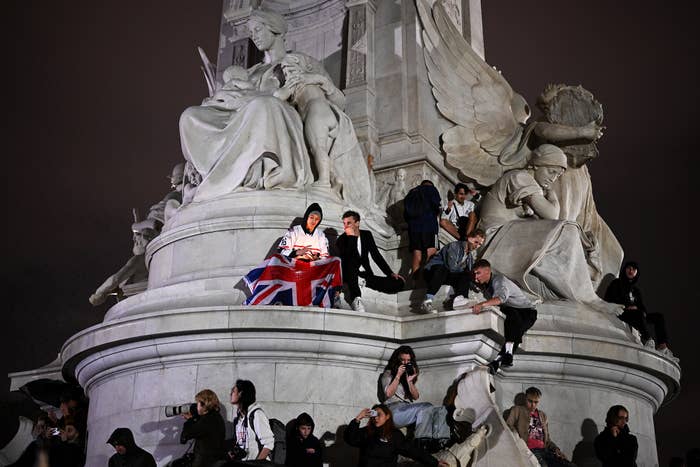
Hours before Buckingham Palace announced the death of Queen Elizabeth, my partner and I were revisiting a piece of journalism published by the Guardian in 2017 that outlines in great detail the secret plan of exactly what will happen after the Queen dies.
“The most elaborate plans are for what happens if she passes away at Balmoral, where she spends three months of the year,” it read, referring to the Queen’s estate in Scotland. After her body lies in state in Edinburgh, the Guardian reported, “the coffin will be … put on board the Royal Train at Waverley station for a sad progress down the east coast mainline.” Authorities expected a wave of national mourning in the UK. “Crowds are expected at level crossings and on station platforms the length of the country … to throw flowers on the passing train.”
Neither one of us is really sure exactly what it was about this last image — thousands waiting at train stations across the UK to throw flowers at a passing train — but we were both briefly overcome with tears. The tears did not return again until a BBC announcer emotionally reported that the Queen had died at Balmoral in Scotland. Immediately, I imagined crowds of people dropping what they were doing — work? school? — to make their way to their local station and await their opportunity to give their own bouquets.
I am not a monarchist. I grew up in Sudan, a former British colony that gained independence in 1956, four years into Elizabeth’s reign. The British were, for much of my childhood, the chief villains in Sudan’s history. I now live in Canada, where the Queen was our head of state; her picture hangs in schools and in government buildings. In either case, the monarchy has not played a significant part of my life. To become a Canadian citizen, I had to swear an oath to the Queen, but that’s about the extent of our relationship. I, like many Canadians, am benignly ambivalent about the monarchy.
I, like many Canadians, am benignly ambivalent about the monarchy. So I found myself surprised to be shedding a tear.
So I found myself surprised to be shedding a tear as I watched members of the royal staff post news of the Queen’s death, as is customary, on the gate of the palace. Hundreds gathered to take photos of the announcement. Meanwhile, news anchors carefully and gravely recounted the decades Elizabeth had reigned over, which included 15 different British prime ministers, dozens of wars and geopolitical conflicts, and a global pandemic.
As news networks rolled out mournful programming that had been on deck for years, I realized that my emotion had little to do with the meaning of the monarchy in my life, but rather the scale and grand solemnity of the occasion. In a cultural moment and a media ecosystem that feels eternally and irreparably fractured, there are surprisingly few figures who are shared reference points for so many people. The once-ubiquitous monoculture is fading into the rearview, but the death of the Queen cuts across cultural silos. She was the head of state in the UK and 14 other Commonwealth nations. The solemnity may be performed, or even overwrought, but the Queen’s death resonates because she was one of our last universal touchpoints.

In the wake of the Queen’s death, social media has often felt like a split screen. Earnest posts mourning her death appear alongside sarcastic shitposts. The earnest crowd focused on her years of service — 70 years as Queen — and praised her duty. The shitposters mocked the earnest crowd for their narrow vision of the Queen’s legacy.
In fairness, much of the mainstream coverage has, unsurprisingly, been devoid of serious criticism. Publications have tended to focus on the “stability” and “calm she brought to the monarchy” and her “graceful” leadership. It’s reasonable to find this kind of unserious engagement with her colonial legacy — and that of the British throne — cloying, and missing half the picture. After all, the Queen was a key figure in papering over the British Empire’s horrors.
That erasure of royal criticism has been ongoing for over two decades — at least until the death of Princess Diana in 1997, since the Queen’s often complicated relationship with the princess was well documented and a part of her public image. The press understood the Queen to be a compelling but stubborn figure. Yet in the last 20 years of Elizabeth’s life, the royal family has managed to overhaul her image, to focus on her wholesome Christmas addresses, her devotion to her family, and her corgis.
The Queen was a continuously visible figure during many major world events, and people’s relationship to her was personal.
Netflix’s The Crown, which debuted in 2016, introduced a new generation to Elizabeth’s fierceness as she admonished prime ministers and put people in their place. That representation collided with the innocent corgi-filled images to make for a narrative of a sweet older woman who was once a badass (or, as Paris Hilton memorably put it earlier today, “the original girl boss”). Little room was made for dissecting her failures or those of the monarchy to reckon with its past.
But what the sarcastic posters miss is mourners’ heartfelt connection to a figure who has managed to remain relevant and central to public life for seven decades. The Queen was a continuously visible figure during many major world events, and people’s relationship to her was personal. She transcended the royal family and even transcended the monarchy itself — she became the fixation. It’s why, perhaps, she was more popular than ever this year, even as the institution was in turmoil. The rifts in the family have become the primary story of the royals, especially in the wake of Prince Harry and Meghan, Duchess of Sussex, publicly breaking from the monarchy. The Queen was the last vestige of royal stability, and the future of the firm now seems unknown.
I remain indifferent to the monarchy. Its brand is clearly in crisis, and King Charles III has been rather unpopular for years. But when I think of thousands of mourners chasing after a train to pay tribute to Queen Elizabeth II in the coming days, I don’t imagine it is exclusively about the monarchy or even the royal family. I imagine it is a deep sadness over losing a figure they felt they’d known for their whole lives. I imagine that the magnitude of their sadness is private and personal; it just so happens to be shared with millions of others. ●
